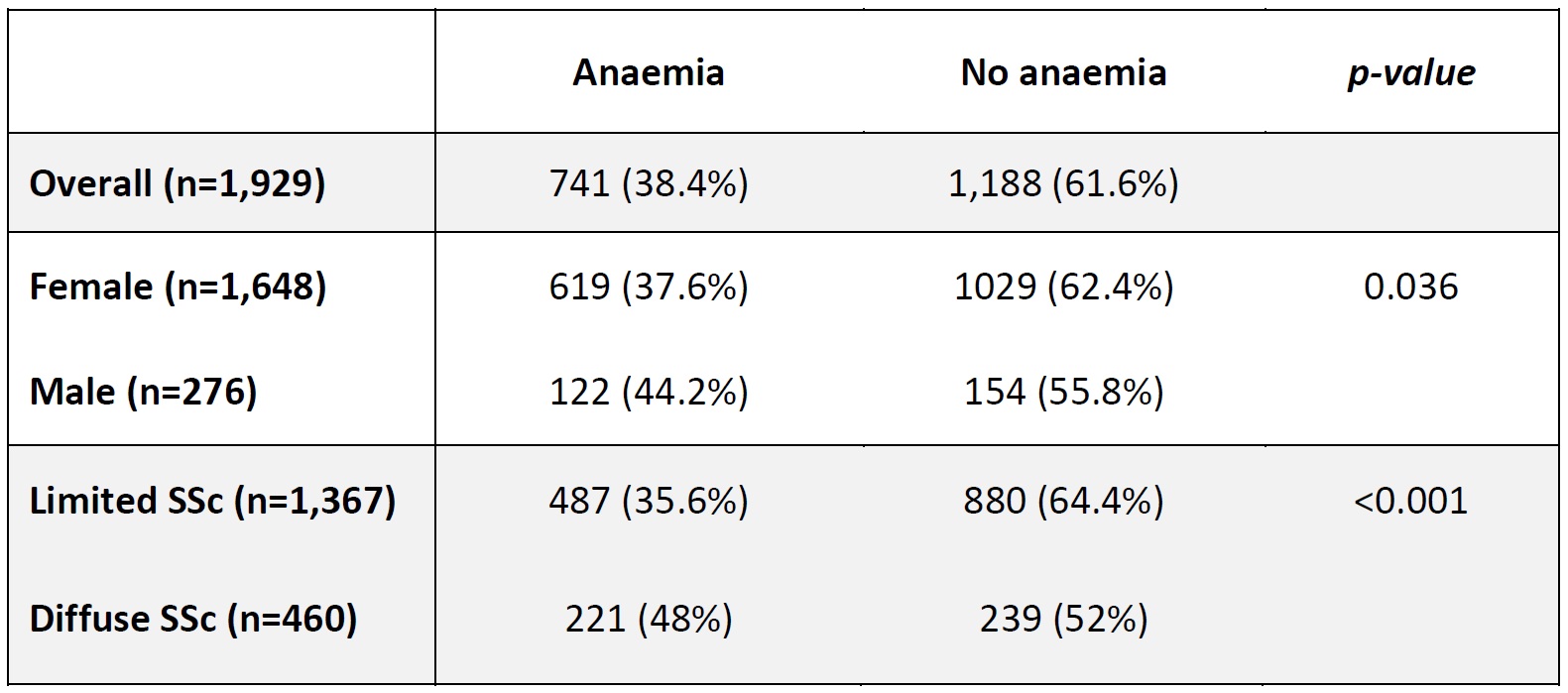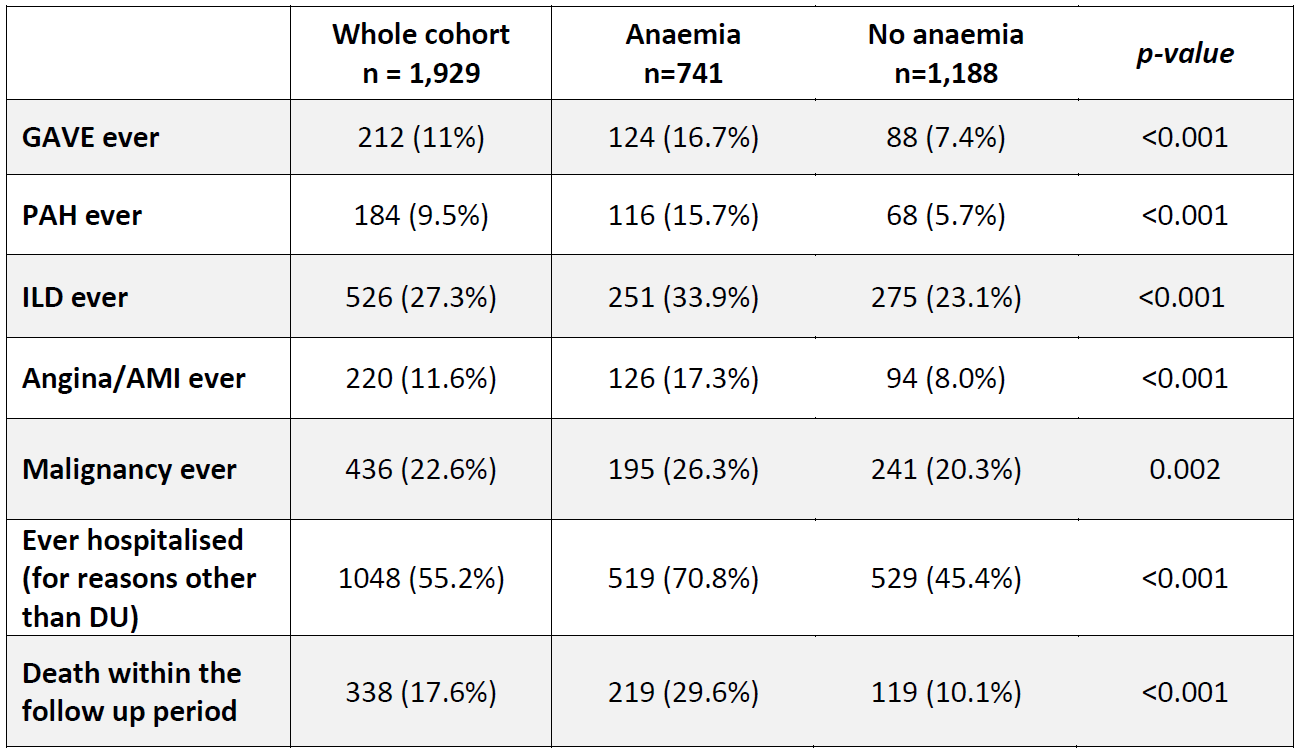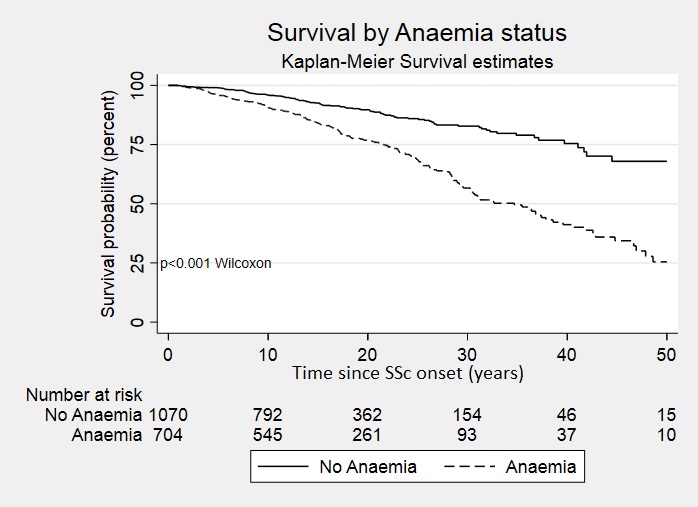Session Information
Date: Sunday, November 12, 2023
Title: (0609–0672) Systemic Sclerosis & Related Disorders – Clinical Poster I: Research
Session Type: Poster Session A
Session Time: 9:00AM-11:00AM
Background/Purpose: Anaemia in systemic sclerosis (SSc) is under-studied and under-characterised. Its prevalence amongst SSc patients is not well described, nor are its effects on outcomes and survival. The aim of this study was to report the prevalence and nature of anaemia in a large national SSc cohort, and the associations with SSc disease manifestations, malignancy, hospitalisations, and mortality.
Methods: Data prospectively collected between 2007 and 2019 as part of the Australian Scleroderma Cohort Study (ASCS) were used. All ASCS patients meeting 2013 SSc ACR/EULAR criteria were included. The prevalence of anaemia (defined as ever having a haemoglobin < 120 g/L for females and < 130 g/L for males) and severe anaemia (defined as ever having a haemoglobin < 80 g/L) were calculated. The median lowest haemoglobin ever was calculated, as was the median time to anaemia diagnosis from SSc disease onset. Anaemia status by sex and disease subclass was also assessed. Proportions of anaemic patients who experienced gastric antral vascular ectasia (GAVE), interstitial lung disease (ILD), pulmonary arterial hypertension (PAH), angina/acute myocardial infraction (AMI), malignancy, hospitalisation, and death were calculated. P-values were generated by chi square test for categorical variables, and by Wilcoxon rank-sum test for continuous variables. Survival analysis was performed using Kaplan-Meier survival estimates.
Results: Of 1,929 patients, 38.4% experienced anaemia (Table 1) and 1.3% experienced severe anaemia. Anaemia affected 44.2% of males and 37.6% of females (p= 0.036). The proportion of patients with diffuse SSc who had anaemia was 48%, compared to 35.6% of those with limited SSc (p< 0.001). The median lowest ever haemoglobin recorded was 125 g/L (interquartile range (IQR): 114 -133) amongst the whole cohort, and 110 g/L (IQR: 101-116) amongst the anaemic group (p< 0.001). The median time to anaemia diagnosis from SSc disease onset was 10.49 years (IQR: 3.91-19.46). More anaemic patients experienced GAVE compared to non-anaemic patients (16.7% vs. 7.4%, p< 0.001) (Table 2). Similarly, PAH occurred more often in anaemic patients (15.7% vs. 5.7%, p< 0.001), as did ILD (33.9% vs. 23.1%, p< 0.001), angina/AMI (17.3% vs. 8%, p< 0.001), and malignancy (26.3% vs. 20.3%, p= 0.002). More anaemic patients were hospitalised ≥ 1 time (for reasons other than digital ulcers) compared to non-anaemic patients (70.8% vs. 45.4%, p< 0.001). Death within the follow up period occurred more often in the anaemic group (29.6% vs. 10.1%, p< 0.001). Survival was significantly worse in those with anaemia (p< 0.001, Figure 1).
Conclusion: To our knowledge, this is the first study to report prevalence of all-cause anaemia in a large SSc cohort. The prevalence of anaemia in the ASCS was substantial at 38.4%. Severe anaemia was rare. A greater prevalence of anaemia was seen in male patients and in those with diffuse disease. Frequencies of GAVE, cardiopulmonary disease, and malignancy, were higher in anaemic patients, as were hospital admissions and mortality. These findings may guide clinical practice, prompting clinicians to be vigilant for concomitant anaemia in SSc, and to monitor more closely for these associations.
Values are expressed as number (%). Abbreviations: SSc – systemic sclerosis.
Values are expressed as number (%). Abbreviations: GAVE – gastric antral vascular ectasia, PAH – pulmonary arterial hypertension, ILD – interstitial lung disease, AMI – acute myocardial infraction, DU – digital ulcers.
Abbreviations: SSc – systemic sclerosis.
To cite this abstract in AMA style:
Barallon R, Ngian G, Apostolopoulos D, Hansen D, Morrisroe K, Stevens W, Proudman S, Nikpour M, Sahhar J. Prevalence and Associations of Anaemia in Systemic Sclerosis Patients in a National Observational Cohort; Results from the Australian Scleroderma Cohort Study [abstract]. Arthritis Rheumatol. 2023; 75 (suppl 9). https://acrabstracts.org/abstract/prevalence-and-associations-of-anaemia-in-systemic-sclerosis-patients-in-a-national-observational-cohort-results-from-the-australian-scleroderma-cohort-study/. Accessed .« Back to ACR Convergence 2023
ACR Meeting Abstracts - https://acrabstracts.org/abstract/prevalence-and-associations-of-anaemia-in-systemic-sclerosis-patients-in-a-national-observational-cohort-results-from-the-australian-scleroderma-cohort-study/



